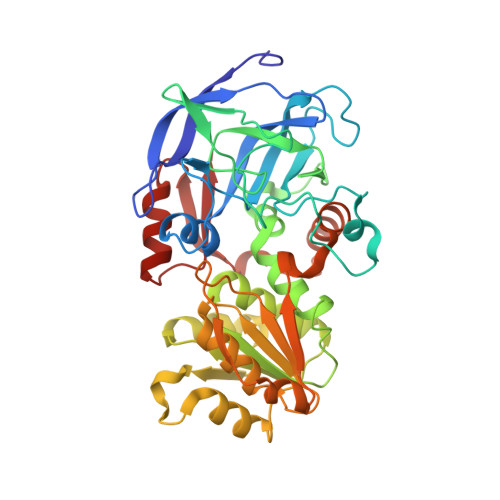Formamides mimic aldehydes and inhibit liver alcohol dehydrogenases and ethanol metabolism
Venkataramaiah, T.H., Plapp, B.V.(2003) J Biological Chem 278: 36699-36706
- PubMed: 12855684
- DOI: https://doi.org/10.1074/jbc.M305419200
- Primary Citation of Related Structures:
1P1R - PubMed Abstract:
Formamides are unreactive analogues of the aldehyde substrates of alcohol dehydrogenases and are useful for structure-function studies and for specific inhibition of alcohol metabolism. They bind to the enzyme-NADH complex and are uncompetitive inhibitors against varied concentrations of alcohol. Fourteen new branched chain and chiral formamides were prepared and tested as inhibitors of purified Class I liver alcohol dehydrogenases: horse (EqADH E), human (HsADH1C*2), and mouse (MmADH1). In general, larger, substituted formamides, such as N-1-ethylheptylformamide, are better inhibitors of HsADH1C*2 and MmADH1 than of EqADH, reflecting a few differences in amino acid residues that change the sizes of the active sites. In contrast, the linear, alkyl (n-propyl and n-butyl) formamides are better inhibitors of EqADH and MmADH1 than of HsADH1C*2, probably because water disrupts van der Waals interactions. These enzymes are also inhibited strongly by sulfoxides and 4-substituted pyrazoles. The structure of EqADH complexed with NADH and (R)-N-1-methylhexylformamide was determined by x-ray crystallography at 1.6 A resolution. The structure resembles the expected Michaelis complex with NADH and aldehyde, and shows for the first time that the reduced nicotinamide ring of NADH is puckered, as predicted for the transition state for hydride transfer. Metabolism of ethanol in mice was inhibited by several formamides. The data were fitted with kinetic simulation to a mechanism that describes the non-linear progress curves and yields estimates of the in vivo inhibition constants and the rate constants for elimination of inhibitors. Some small formamides, such as N-isopropylformamide, may be useful inhibitors in vivo.
- Department of Biochemistry, The University of Iowa, Iowa City, Iowa 52242, USA.
Organizational Affiliation:




















